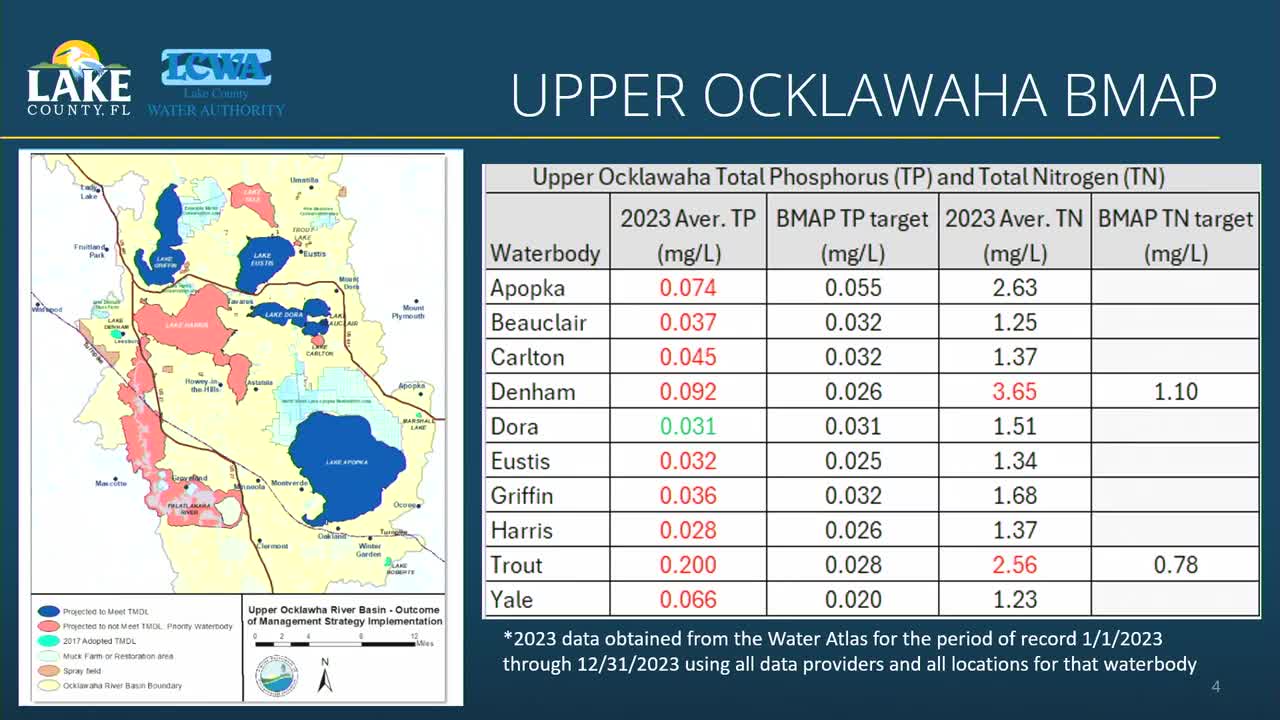Water quality crisis deepens as pollution sources revealed
September 18, 2024 | Lake County, Florida
This article was created by AI summarizing key points discussed. AI makes mistakes, so for full details and context, please refer to the video of the full meeting. Please report any errors so we can fix them. Report an error »

In a recent government meeting, officials discussed the ongoing challenges and progress in managing water quality in several local lakes, particularly focusing on phosphorus loading sources. The meeting highlighted that atmospheric deposition, which refers to pollutants falling from the sky, is the primary contributor to phosphorus levels in Lake Apopka and Lake Harris, followed closely by stormwater runoff. This atmospheric source is largely uncontrollable, while stormwater runoff presents an opportunity for local management efforts.
Lake Apopka has shown significant improvement, meeting its phosphorus reduction target, although a correction was noted regarding a £5,000 credit that was mistakenly attributed to it instead of Lake Victoria. Meanwhile, Lake Beauclair continues to require substantial work to meet its targets, while Lake Carlton has specific cleanup allocations assigned to various entities, with some exceeding their targets.
Sampling efforts across multiple sites, including the NERF (Nutrient Reduction Facility) and Lake Lena Lane, revealed fluctuating phosphorus levels, with some locations exceeding targets. Notably, the removal of vegetation at Lake Lena Lane correlated with a spike in phosphorus levels, raising concerns about the impact of land management practices on water quality.
The meeting also addressed the importance of ongoing monitoring, with data collected both monthly and bi-weekly to better understand the dynamics of phosphorus and nitrogen levels across different sites. The results indicate that while some areas are performing well, others, particularly those near septic tanks, are contributing to higher nitrogen levels.
Overall, the discussions underscored the complexity of managing water quality in the region, emphasizing the need for continued collaboration among local agencies and stakeholders to address these environmental challenges effectively.
Lake Apopka has shown significant improvement, meeting its phosphorus reduction target, although a correction was noted regarding a £5,000 credit that was mistakenly attributed to it instead of Lake Victoria. Meanwhile, Lake Beauclair continues to require substantial work to meet its targets, while Lake Carlton has specific cleanup allocations assigned to various entities, with some exceeding their targets.
Sampling efforts across multiple sites, including the NERF (Nutrient Reduction Facility) and Lake Lena Lane, revealed fluctuating phosphorus levels, with some locations exceeding targets. Notably, the removal of vegetation at Lake Lena Lane correlated with a spike in phosphorus levels, raising concerns about the impact of land management practices on water quality.
The meeting also addressed the importance of ongoing monitoring, with data collected both monthly and bi-weekly to better understand the dynamics of phosphorus and nitrogen levels across different sites. The results indicate that while some areas are performing well, others, particularly those near septic tanks, are contributing to higher nitrogen levels.
Overall, the discussions underscored the complexity of managing water quality in the region, emphasizing the need for continued collaboration among local agencies and stakeholders to address these environmental challenges effectively.
View full meeting
This article is based on a recent meeting—watch the full video and explore the complete transcript for deeper insights into the discussion.
View full meeting